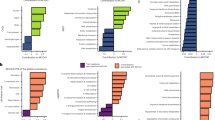Abstract
COPE'S rule―the generalization that animal taxa tend to evolve toward larger body size―suggests that there are widespread net selective advantages to being large1–4. Size–abundance relationships within bird4–7 and desert rodent4 guilds show that larger species usually do control more energy locally, and thus maintain larger populations than expected for their body size, implying that larger individuals are relatively better at obtaining and using local resources. But we report here results that show that this is not generally the case among mammal species. Within dietary groups containing only small species, larger species usually do better, but within those that contain the largest mammals, small species tend to control more energy. This suggests that in mammals there is an optimum body size for energy acquisition at about 1 kg. Thus, net adaptive advantages of large individuals for resource control cannot be used as a general explanation for evolutionary size increase in mammals, although other proposed explanations for Cope's rule are unaffected8–10. Instead, these results suggest a partial explanation for another widespread ecotypic pattern, the 'island rule': that on islands, small mammal species evolve to larger size and large species to smaller size11–13. If on an island a species' usual competitors and predators are absent, it should often tend to evolve toward the optimum body size, and the adaptive advantages of doing so would be greatest for populations starting at body-size extremes.
This is a preview of subscription content, access via your institution
Access options
Subscribe to this journal
Receive 51 print issues and online access
$199.00 per year
only $3.90 per issue
Buy this article
- Purchase on Springer Link
- Instant access to full article PDF
Prices may be subject to local taxes which are calculated during checkout
Similar content being viewed by others
References
Rensch, B. Evolution above the Species Level (Columbia Univ. Press, New York, 1959).
Newell, N. D. Evolution 3, 103–124 (1949).
Gould, S. J. Biol. Rev. 41, 587–640 (1966).
Brown, J. H. & Maurer, B. A. Nature 324, 248–250 (1986).
Nee, S., Read, A. F., Greenwood, J. J. D. & Harvey, P. H. Nature 351, 312–313 (1991).
Juanes, F. Am. Nat. 128, 921–929 (1986).
Cotgreave, P. & Harvey, P. H. Functional Ecol. 6, 248–256 (1992).
Stanley, S. M. Evolution 27, 1–26 (1973).
Van Valen, L. M. Evolution 29, 87–94 (1975).
Gould, S. J. J. Paleont. 62, 319–329 (1988).
Foster, J. B. Nature 202, 234–235 (1964).
Van Valen, L. M. Evol. Theory 1, 31–49 (1973).
Lomolino, M. V. Am. Nat. 125, 310–316 (1985).
Lawton, J. H. Oikos 55, 429–434 (1989).
Lewontin, R. C. & Levins, R. Am. Nat. 134, 513–524 (1989).
Damuth, J. Nature 351, 268–269 (1991).
Kleiber, M. The Fire of Life 2nd edn (Krieger, New York, 1975).
Nagy, K. A. Ecol. Monogr. 57, 111–128 (1987).
Damuth, J. Nature 209, 699–700 (1981).
Damuth, J. Biol. J. Linn. Soc. 31, 193–246 (1987).
Damuth, J. Nature 351, 268–269 (1991).
Robinson, J. G. & Redford, K. H. Am. Nat. 128, 665–680 (1986).
Pagel, M. D. & Harvey, P. H. Am. Nat. 132, 344–359 (1988).
du Toit, J. T. & Owen-Smith, N. Am. Nat. 133, 736–740 (1989).
Maiorana, V. C. in Body Size in Mammalian Paleobiology (eds Damuth, J. & MacFadden, B. J.) 69–102 (Cambridge Univ. Press, 1990).
Sondaar, P. Y. in Major Patterns of Vertebrate Evolution (eds Hecht, M. K., Goody, P. C & Hecht, B. M.) 671–707 (Plenum, New York, 1977).
Heaney, L. R. Evolution 32, 29–44 (1978).
Eisenberg, J. F. The Mammalian Radiations (Univ. Chicago Press, 1981).
Hofmann, R. R. & Stewart, D. R. M. Mammalia 36, 226–240 (1972).
Kuhry, B. & Marcus, L. F. Syst. Zool. 26, 201–209 (1977).
Riggs, D. S., Guarnieri, J. A. & Addelman, S. Life Sci. 22, 1305–1360 (1978).
McArdle, B. H. Can. J. Zool. 66, 2329–2339 (1988).
Yablokov, A. V. Variability of Mammals (Amerind, New Delhi, 1974).
Caughley, G. Analysis of Vertebrate Populations (Wiley, London, 1977).
Felsenstein, J. Am. Nat. 125, 1–15 (1985).
Ridley, M. J. theor. Biol. 136, 361–364 (1989).
Author information
Authors and Affiliations
Rights and permissions
About this article
Cite this article
Damuth, J. Cope's rule, the island rule and the scaling of mammalian population density. Nature 365, 748–750 (1993). https://doi.org/10.1038/365748a0
Received:
Accepted:
Issue Date:
DOI: https://doi.org/10.1038/365748a0
This article is cited by
-
Ecological determinants of Cope’s rule and its inverse
Communications Biology (2024)
-
The island rule explains consistent patterns of body size evolution in terrestrial vertebrates
Nature Ecology & Evolution (2021)
-
A unifying theory for top-heavy ecosystem structure in the ocean
Nature Communications (2018)
-
Hoplitomerycidae (Late Miocene, Italy), an Example of Giantism in Insular Ruminants
Journal of Mammalian Evolution (2015)
-
Diversity and Evolution of Body Size in Fishes
Evolutionary Biology (2012)
Comments
By submitting a comment you agree to abide by our Terms and Community Guidelines. If you find something abusive or that does not comply with our terms or guidelines please flag it as inappropriate.



